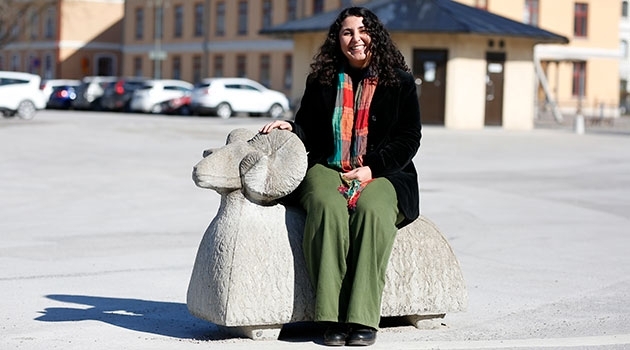The sheep – Gotland’s symbol of sustainability
Sheep are the strongest symbol of sustainability on Gotland, according to Gurbet Peker. Not only do real ones graze all over the island, you can even find sheep sculpted in concrete in Visby. Peker researches the day-to-day lives of lamb farmers in the Gotland countryside.
Gurbet Peker is a doctoral student at the Graduate School in Sustainability Studies at Campus Gotland. As an ethnologist, she studies people from an everyday perspective, here focusing on how sustainability is practised, negotiated and problematized. Sustainability and sustainable development very often begin with day-to-day life, where the possible is distinguished from the impossible.
“What I want, or my ideas may not always line up with what happens in practice,” says Gurbet Peker.
How did you get hooked on sheep?
“There's something about the sheep here. I see them everywhere, from the ferry to the island. Different companies use the sheep as a symbol and, for tourists, part of the Gotland experience is seeing sheep, living or otherwise. The handicraft shops are full of sheep-related products.”
A living cultural heritage
The sustainability aspect is that sheep are a living cultural heritage on Gotland.
“They’ve been here for a long time, the people here have worked with sheep for a long time. Sheep have literally helped to shape the landscape.”
Even today, there are many lamb farmers on Gotland, selling not only sheepskins but also mutton, which is becoming increasingly popular. In this way, sheep contribute to economic sustainability and provide jobs. But it's also about social sustainability, according to Gurbet Peker.
“The lambs allow people to interact with each other, both in the countryside and in Visby. That includes interactions among farmers, between farmers and butchers or spinning and scouring mills and with rural developers and planners from the regional government.
Observing and interviewing
Gurbet Peker has three years left in the project, which has been running for a year. She works with ethnographic methods and conducts fieldwork where she observes and interviews lamb farmers, among others.
“We discuss anything from their land, routines, and working methods to interactions with the lambs. Another interview topic can be the type of lamb they raise, since not everyone has Gotland lambs.”
From her conversations, she understands that sheep give rise to many emotions and sometimes even conflicts.
“Some want white lambs for meat production while others want to stick to Gotland breeds that are more linked to Gotland as a place. Many divergent views on sheep management raise the question of what can be sustainable here.”
Difficult to live up to ideals
Peker then compares farmers' statements with what they actually do on their farms. As is the case for most of us, living up to sustainability ideals can be difficult.
“It may be that you want to locate your farm store where you sell your sheepskins and other local products. But at the same time, you rely on your car, on diesel, and perhaps on foreign hay.
Many farmers rely on other farmers who rent out their fields or grow crops. This makes it difficult to go one's own way, since one must constantly adapt to what others do or think.
“Numerous laws and regulations also make it difficult not to focus on the short-term and the bottom line in certain situations,” Gurbet Peker says. “It's easy to believe that you should grow hay locally, but it can be difficult to actually do so in practice. That is to say, sustainability work can be easier in theory than on the ground.”
Annica Hulth

